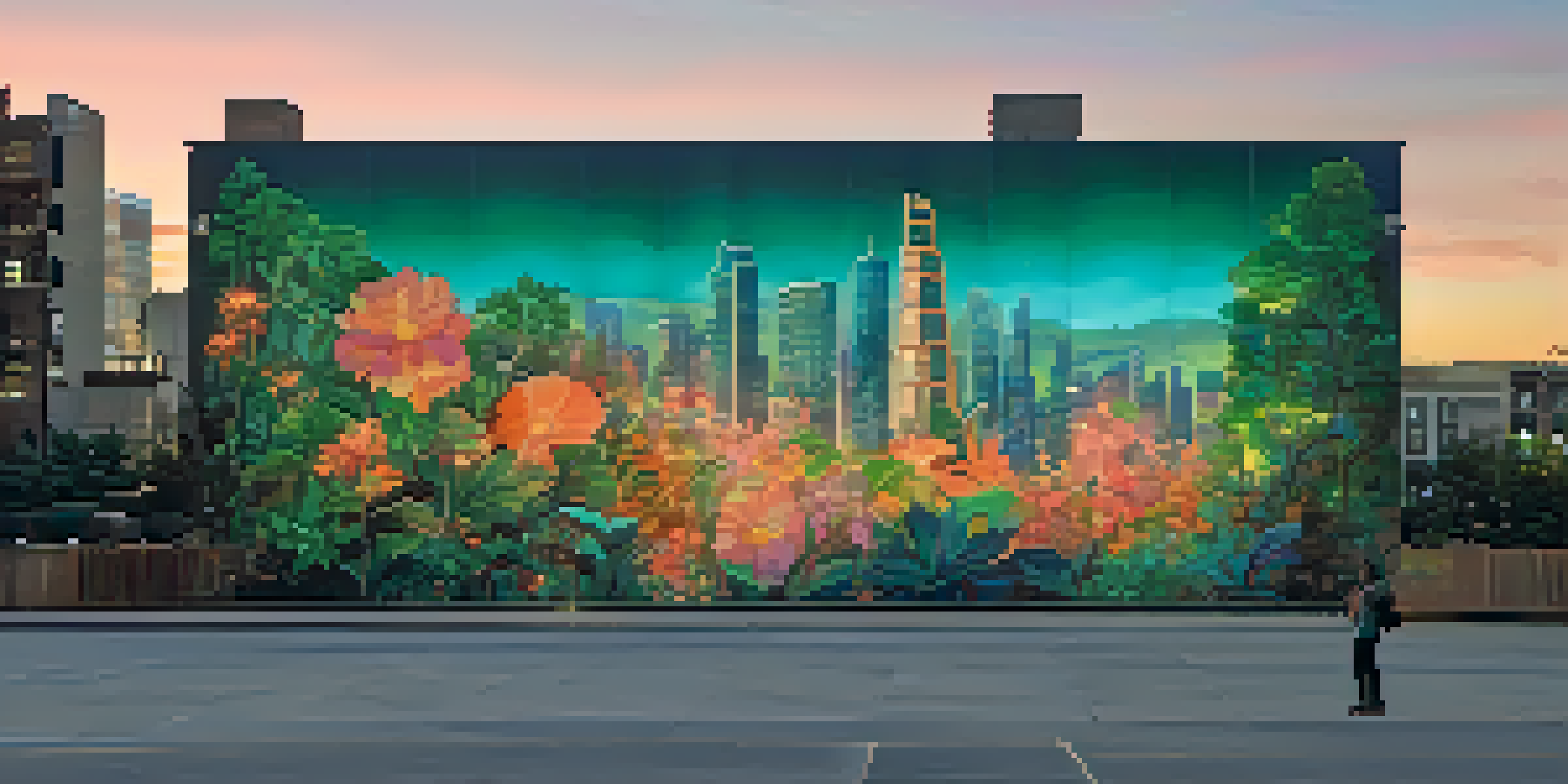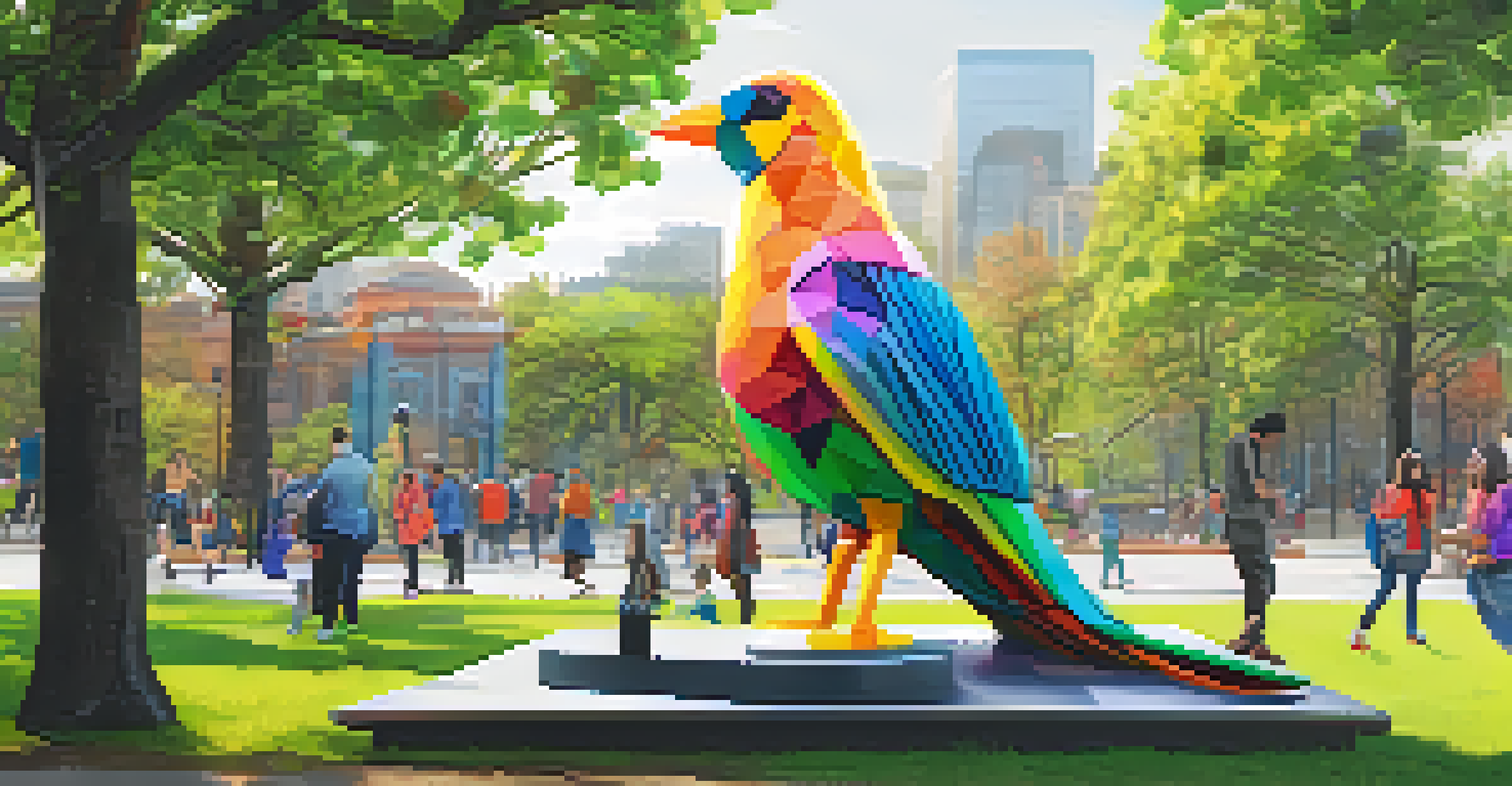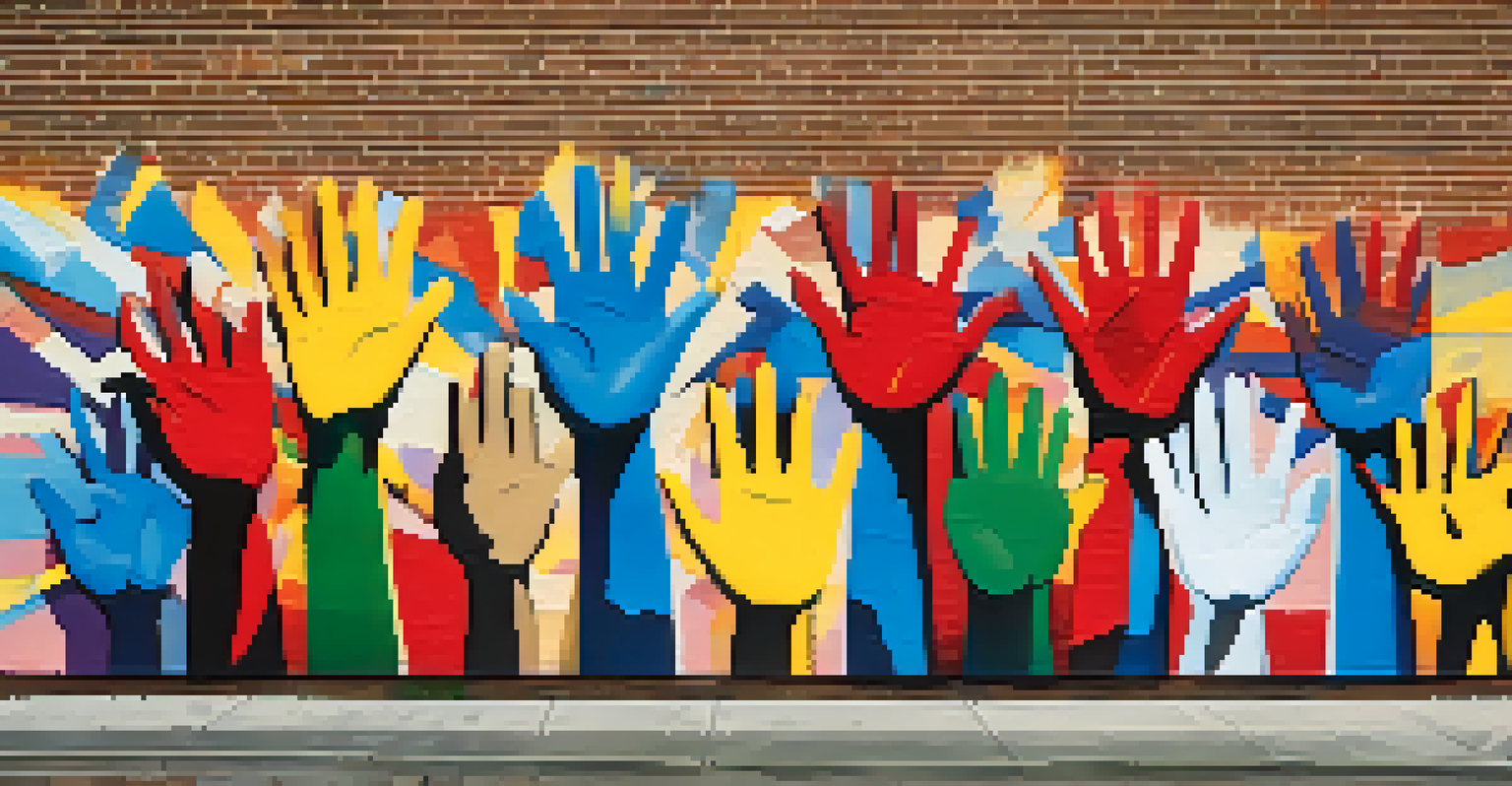Digital Street Art: Transforming Public Spaces for Change

What is Digital Street Art and Its Impact?
Digital street art is a modern evolution of traditional graffiti, merging technology with creativity. Using tools like projection mapping and augmented reality, artists can transform public spaces into vibrant canvases that engage viewers in unique ways. This innovative approach not only beautifies urban areas but also ignites conversations about social issues.
Art should comfort the disturbed and disturb the comfortable.
For instance, a digital mural projected onto a building can change themes overnight, reflecting current events or societal challenges. This flexibility allows artists to respond to the world around them quickly, making their work more relevant and impactful. Digital street art, therefore, serves as both an artistic expression and a powerful medium for social commentary.
Moreover, the accessibility of digital tools means that more voices can be heard in the art world. Artists from diverse backgrounds are using technology to share their stories and perspectives, enriching the cultural landscape of our cities. In this way, digital street art fosters inclusivity and democratizes the art experience.
The Role of Technology in Street Art
Technology plays a crucial role in the evolution of street art, enabling artists to create stunning visuals that were once impossible. From digital projectors to apps that augment reality, these tools enhance the artist's ability to connect with audiences. Imagine walking down a street and seeing a static mural come to life through your smartphone—it’s a captivating experience.

One popular technique is projection mapping, which allows artists to display their work on various surfaces, transforming them into dynamic art installations. This method not only changes how we perceive public spaces but also encourages interaction from passersby. The element of surprise and interactivity keeps audiences engaged and makes art more approachable.
Digital Art as Social Commentary
Digital street art transforms public spaces into platforms for expressing urgent social issues and engaging communities.
Additionally, social media platforms have become a vital part of this movement, allowing artists to showcase their work to a global audience. A mural in a local neighborhood can gain international attention through a single post, creating a ripple effect that inspires others to engage with street art. This digital sharing adds another layer to the conversation around public art and its significance in society.
How Digital Street Art Raises Social Awareness
Digital street art often tackles pressing social issues, using public spaces as platforms for advocacy. Artists leverage their creativity to comment on topics such as climate change, racial equality, and mental health, making these conversations more accessible to the public. A powerful image can spark dialogue and encourage action, transforming spectators into participants.
Creativity takes courage.
For instance, murals depicting the effects of pollution or social injustice can create a visceral connection, prompting viewers to reflect on their role in these issues. By placing art in everyday environments, artists remind us that these topics are not just abstract concepts—they're part of our community and our lives. This approach demystifies complex issues and fosters a sense of urgency to address them.
Furthermore, digital street art can unite communities around shared values and goals. Collaborative projects often bring together diverse groups of people, allowing them to express their concerns and aspirations through art. These collective efforts can strengthen community bonds and inspire local activism, ultimately leading to meaningful change.
The Intersection of Art and Activism
Digital street art is not just about aesthetic appeal; it embodies the spirit of activism. Many artists use their platforms to challenge authority and provoke thought, often at great personal risk. By boldly addressing social injustices through their art, they inspire others to engage with these issues and advocate for change.
Consider the powerful murals that emerged during social movements, such as Black Lives Matter. Artists have used their skills to create striking images that resonate with the public, amplifying the voices of those who feel marginalized. This intersection of art and activism transforms public spaces into arenas for political discourse, encouraging citizens to reflect and respond.
Technology Enhances Artistic Expression
Innovative tools like projection mapping and augmented reality allow artists to create dynamic, interactive experiences that captivate audiences.
Moreover, the ephemeral nature of digital street art adds to its potency. As quickly as a work can appear, it can also be removed, creating a sense of urgency that resonates with viewers. This fleeting quality emphasizes the importance of the messages conveyed, reminding us that change is often both necessary and immediate.
Challenges Faced by Digital Street Artists
Despite its potential, digital street art is not without challenges. Legal issues often arise, as many artists grapple with the fine line between public expression and vandalism. While some cities embrace street art and provide designated spaces, others view it strictly as graffiti, leading to conflicts and potential penalties for artists.
Additionally, the rapid evolution of technology means that artists must continually adapt to new tools and trends. This can be both exciting and daunting, as keeping pace with technological advancements is essential to stay relevant in the digital art scene. The pressure to innovate can sometimes overshadow the artistic process, leading to burnout among creators.
Finally, the commercialization of street art presents another challenge. As digital street art gains popularity, some artists find their work commodified, losing the rawness and authenticity that initially motivated them. Striking a balance between artistic integrity and commercial success is crucial for many artists navigating this evolving landscape.
The Future of Digital Street Art
Looking ahead, the future of digital street art appears promising and full of potential. As technology continues to advance, artists will have even more tools at their disposal to create immersive experiences that captivate audiences. Innovations like virtual reality could take street art to new heights, offering viewers an interactive experience that blurs the lines between reality and art.
Moreover, as public attitudes toward street art shift, we may see more cities embracing and supporting these initiatives. With growing recognition of the cultural and social value of street art, local governments may provide funding and resources for artists to create meaningful works. This could lead to a flourishing community of digital street artists who are encouraged to explore their creativity.
Art and Activism Unite
Digital street art serves as a powerful medium for activism, inspiring dialogue and action around pressing societal challenges.
Ultimately, the power of digital street art lies in its ability to foster connection and inspire change. As artists continue to push boundaries, we can expect to see more transformative works that not only beautify our cities but also challenge us to reflect on the world we live in. The future of digital street art is not just about art; it's about creating a dialogue that promotes understanding and social progress.
Conclusion: Embracing the Transformation
Digital street art represents a unique fusion of creativity, technology, and social consciousness. As it continues to evolve, it challenges us to reconsider our relationship with public spaces and the messages they convey. From raising awareness about critical issues to fostering community engagement, digital street art has the power to transform not just walls, but entire neighborhoods.
By embracing this transformation, we can support artists and initiatives that prioritize inclusivity and social change. Whether it's by visiting a local mural or sharing an artist's work on social media, each of us can play a role in amplifying these important conversations. The beauty of digital street art lies in its ability to reach us all, inviting us to participate in the dialogue around art, community, and change.

So, the next time you encounter a digital mural in your city, take a moment to appreciate its deeper meaning. These artworks are not just eye-catching; they are reflections of our society, capturing the hopes, struggles, and aspirations of the communities they inhabit. Together, let's celebrate and support the transformative power of digital street art.